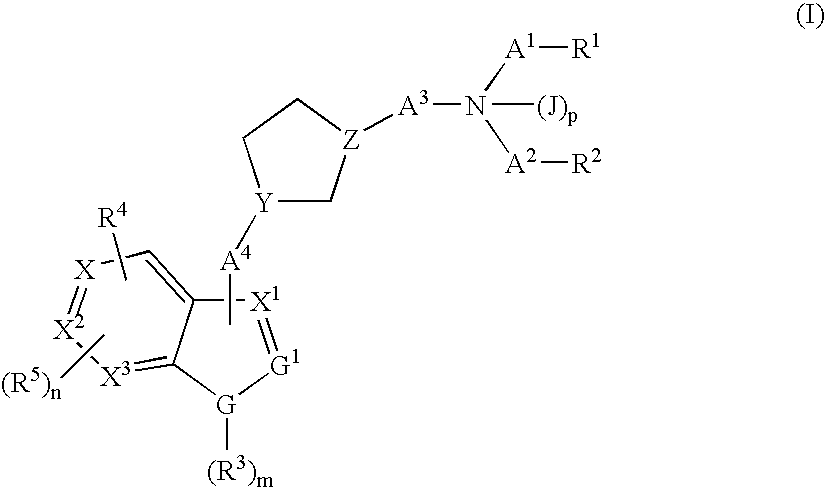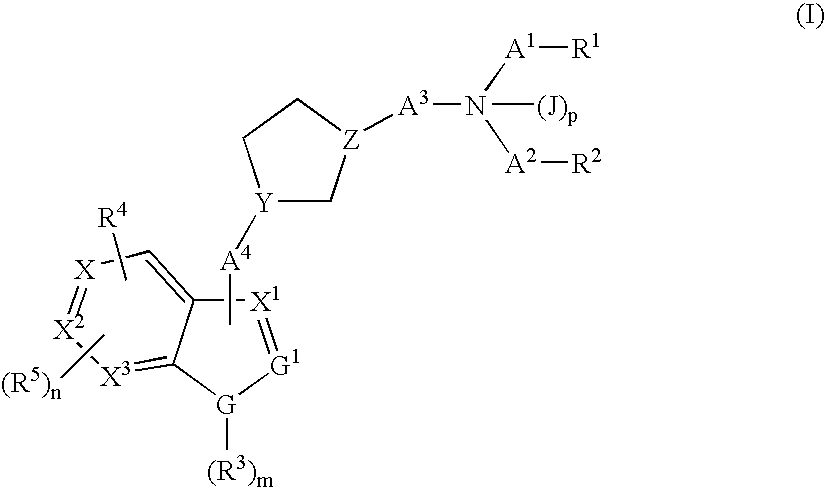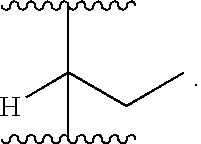Cyclopentyl indole derivatives
a technology of cyclopentyl indole and derivatives, which is applied in the field of cyclopentyl indole derivatives, can solve the problem that none of said patents disclose the use of said derivatives
- Summary
- Abstract
- Description
- Claims
- Application Information
AI Technical Summary
Benefits of technology
Problems solved by technology
Method used
Image
Examples
example 1
3-(3-oxocyclopentyl)-1H-indole-5-carbonitrile
[0134]
[0135]2-Cyclopenten-1-one (4.1 g, 4.2 mL, 50 mMol) was added to a stirred solution of 5-cyanoindole (1.42 g, 10 mMol) and ytterbium triflate hexahydrate (124 mg, 0.2 mMol) in acetonitrile (15 mL). After stirring at room temperature for 7d, the reaction was concentrated to an oil and diluted with ether. The red oily mixture was filtered through celite and the filtrate was concentrated in vacuo. The crude product was purified by flash chromatography on silica gel (35 g) using a gradient of 20–35% ethyl acetate in hexane. Pure product fractions were concentrated and dried under high vacuum to give 3-(3-oxocyclopentyl)-1H-indole-5-carbonitrile (1.55 g, 69%). 1H NMR (500 MHz, CDCl3) δ 8.41 (1 H, bs), 7.99 (1 H, s), 7.45 (2 H, m), 7.12 (1 H, dd, J=2.44, 0.92 Hz), 3.72 (1 H, m), 2.77 (1 H, dd, J=7.63, 18.31 Hz), 2.56 (1 H, m), 2.40 (3 H, m), 2.10 (1 H, m). MS m / e 223.2 (M−H)+. Anal. calcd. for C14H12N2O: C, 74.98; H, 5.39; N, 12.49. Found:...
example 2
3-(5-fluoro-1H-indol-3-yl)-cyclopentanone
[0136]
[0137]The method given in Example 1, using 5-fluoroindole (35.3 mMol), gave 3-(5-fluoro-1H-indol-3-yl)-cyclopentanone (1.29 g, 84%). 1H NMR (500 MHz, CDCl3): δ 8.03 (1 H, bs), 7.30 (1 H, dd, J=8.85, 4.27), 7.26 (1 H, dd, J=9.46, 2.44), 7.04 (1 H, d, J=2.14), 6.97 (1 H, dt, J=8.85, 2.44), 3.66 (1 H, m), 2.75 (1 H, dd, J=7.32, 18.31 Hz), 2.53 (1 H, m), 2.42 (2 H, m), 2.34 (1 H, m), 2.11 (1 H, m). MS m / e 216.04 (M−H)+. Anal. calcd. for C13H12NOF: C, 71.87; H, 5.56; N, 6.44. Found: C, 71.97; H, 5.69; N, 6.31.
example 3
3-(4-Fluoro-1H-indol-3-yl)-cyclopentanone
[0138]
[0139]By the method of Example 1, using 4-fluoroindole (1.35 g, 10.0 mMol) as starting material, 3-(4-fluoro-1H-indol-3-yl)-cyclopentanone (700 mg, 32%) was obtained. 1H NMR (500 MHz, CDCl3) δ ppm 2.09 (m, 1 H) 2.38 (m, 3 H) 2.51 (m, 1 H) 2.74 (dd, J=18.16, 7.78 Hz, 1 H) 3.81 (m, 1 H) 6.77 (dd, J=11.14, 7.78 Hz, 1 H) 6.94 (d, J=2.14 Hz, 1 H) 7.11 (m, 2 H) 8.13 (s, 1 H). MS m / e 216.2 (M−H)−. Anal. calcd. for C13H12NOF: C, 71.87; H, 5.56; N, 6.44. Found: C, 71.90; H, 5.63; N, 6.29.
PUM
| Property | Measurement | Unit |
|---|---|---|
| flow rate | aaaaa | aaaaa |
| pH | aaaaa | aaaaa |
| temperature | aaaaa | aaaaa |
Abstract
Description
Claims
Application Information
 Login to View More
Login to View More - R&D
- Intellectual Property
- Life Sciences
- Materials
- Tech Scout
- Unparalleled Data Quality
- Higher Quality Content
- 60% Fewer Hallucinations
Browse by: Latest US Patents, China's latest patents, Technical Efficacy Thesaurus, Application Domain, Technology Topic, Popular Technical Reports.
© 2025 PatSnap. All rights reserved.Legal|Privacy policy|Modern Slavery Act Transparency Statement|Sitemap|About US| Contact US: help@patsnap.com



